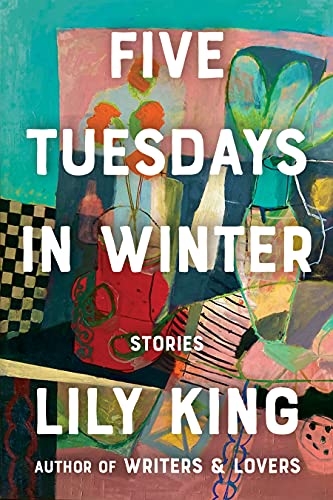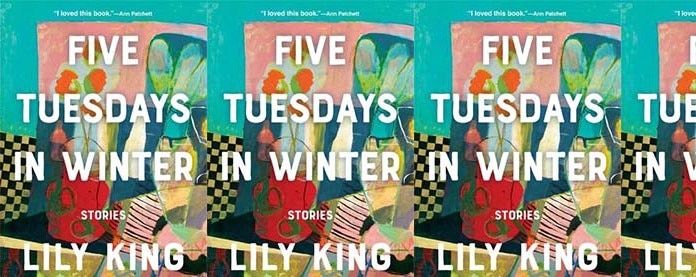
Written by: Lily King
Publisher: Grove Press, hardcover, copyright 2021
Total pages: 25 pages for the short story “Five Tuesdays in Winter”
Genre: Buddy Love
A well-crafted short story is an art form—a thing of beauty and resonance. Last year, I read and enjoyed Lily King’s popular novel, Writers & Lovers (March 2020), which was a New York Times bestseller and a Goodreads Award nominee for Best Fiction. But it was her newly released short story collection, Five Tuesdays in Winter (November 2021), that cemented my love of her writing and staked a claim on my imagination. There are 10 short stories in the book that are unrelated to each other, at least as far as their specific plots and characters, but they’re united in their exploration of love, desire, heartache, and loss, and they kept me up late reading and pondering their themes.
My favorite is the story that shares its title with the collection, “Five Tuesdays in Winter” (pages 43 – 67), the second of the 10 stories. It’s about an emotionally guarded bookseller, his daughter, and a woman who becomes important to them both.
As always, I’m in awe of how applicable Blake Snyder’s beat sheet can be across multiple storytelling domains—novels, films, TV shows, songs, and short fiction, too. To all of us, it’s a gift of structure and insight that we can utilize in our writing and help to strengthen it. I never get tired of seeing these 15 elements in action, and I was delighted to recognize the presence of every beat in Lily King’s beautifully written piece.
I hope you’ll read this short story and the others included in Five Tuesdays in Winter, a collection that received starred reviews from both the Library Journal and Kirkus, and about which Ann Patchett said, “[It] moved me, inspired me, thrilled me. It filled up every chamber of my heart. I loved this book.”
Yes. Me, too.
Opening Image (pages 43 – 44): We’re introduced to 42-year-old divorced bookstore owner Mitchell, his 12-year-old daughter Paula, and his only hired employee, 30-something Kate, who’d moved to Portland, Maine, from San Francisco, to live with her boyfriend. It’s a Saturday in January and all three of them are working at the bookstore together.
Theme Stated (page 44): Young Paula is irritated with her father, whom she disdainfully tags as “reticent,” and is complaining about him within his earshot as she chats with Kate. The definition of the word— not revealing one’s thoughts or feelings readily; being withdrawn, inhibited, or restrained—fits Mitchell well. As readers, we recognize this immediately. What is less apparent until later is that Kate, too, shares this quality. So, when Paula asks Kate, “Isn’t he the most reticent person you’ve ever met?” and Kate replies, “Maybe not the very most,” there’s more behind this short dialogue exchange than it initially appears.
Set-Up (pages 43 – 45): We learn that Mitchell’s parents both died, as did his best friend when he was younger, and these losses impacted him deeply. His wife left him, too, because she considered him “emotionally stagnant” with a heart that was “locked shut.” But the wife not only left Mitchell, she also left Paula. While his wife’s absence has made Mitchell shutter his emotions even further, his daughter is far less constricted. Paula is desperate to connect and communicate with him. For him to open up to her and to the world at large. However, he doesn’t have any idea how to do this. He’s attracted to Kate and, in spite of her imperfect spelling and less structured way of being, he admires her from across the bookstore and wishes he could kiss her.
Catalyst (pages 46 – 47): Paula spontaneously suggests that Kate would be the perfect person to tutor her in Spanish, and she railroads her father into considering the idea. Paula says she’s already talked about it with Kate and that Kate can come to their house on Tuesdays.
Debate (page 47): Thrown by this potential change in their routine and not knowing how to reply, Mitchell stumbles in his response, questioning Kate’s fluency. Kate explains that she’s never taught Spanish, but she did live for two years in Peru. She’s conversational with the language, which is an advantage Paula quickly jumps on. Paula insists that she doesn’t get nearly enough time speaking Spanish in the classroom, a complaint Mitchell never heard her voice until now. He debates the necessity of this tutoring plan, but he loves his daughter and agrees to go along with it if she thinks it’ll be of help.
Break into Two (pages 47 – 48): It’s the first Tuesday with a tutoring session, and Kate comes to their house. Mitchell can’t help but notice how nicely she’s dressed. He’s disappointed when his daughter spirits Kate away to her bedroom.
B Story (pages 48 – 49): The lessons begin. There are multiple relationships developing simultaneously: The friendship between Kate and Paula, which is a necessary component for Mitchell in order to see his daughter more clearly and, eventually, relate to her a bit better. And, also, having this additional contact with Kate allows him to embark on a tentative but growing friendship/relationship with her.
Fun and Games (pages 51 – 58): Between the weekly Spanish lessons at the house and working daily with Kate at the bookstore, Mitchell begins to admit—if only to himself—how much he looks forward to seeing Kate and how he truly enjoys her company. She’s recently moved to a new apartment and is no longer living with the man she came to Maine to be with, but she goes on a lunch date with a new, potential boyfriend, which concerns Mitchell. He’s drawn to her offbeat sense of humor, and she appears to be amused by his. But most importantly, Kate is thoughtful and doesn’t seem inclined to try to change him. When Kate brings him back some soup (in response to an inside joke they’d shared), Mitchell finds himself entertaining the notion that, in addition to being attracted to her, he likes her.
Midpoint (pages 58 – 59): False victory. One day, when Mitchell is out of sorts because of an annoying customer, he and Kate talk afterward. He not only has a deep emotional revelation but, for once, he actually expresses it aloud to Kate. He’d been thinking about his favorite customer—an older lady named Mrs. White—who’d passed away some time back. Mrs. White was smart and had a great sense of humor, and Mitchell misses her. He tells Kate these things, but he further realizes that the qualities he’d liked so much about the older woman he also sees in Kate. In what is a big moment for a man who’s so reticent about sharing his feelings, he tells Kate that she reminds him of Mrs. White. Coming from him, there couldn’t be a much higher compliment.
Bad Guys Close In (page 59): Given Kate’s ability to meet new people, including customers at the bookstore—one of whom asked her out on a date—Mitchell worries that she’ll soon find a new boyfriend. A male customer comes in and, despite the fact that Kate’s and Mitchell’s eye colors are different shades, this guy studies them standing side by side and says they have “the same kind of eyes.” This is a strangely unsettling observation to Mitchell.
All Is Lost (pages 59 – 60): Whiff of death for their prior employer/employee relationship, which has shifted between them, and their friendship is at an awkward stage. Mitchell doesn’t know how to act around Kate. He can’t speak with her easily, and without his daughter nearby, he has a hard time finding out information about his love interest that he’d like to know. Paula has a way of extracting new and interesting facts from Kate, and he craves more of that. Unfortunately, his daughter has some school-related commitments and won’t be coming to the bookstore that Saturday.
Dark Night of the Soul (pages 60 – 61): Mitchell discovers that the fifth of the Tuesday tutoring sessions will fall on Valentine’s Day, and what’s worse, that this day is also Kate’s birthday. He has no idea what to do. To complicate matters further, Paula tells him that she’s invited Kate to stay for dinner after the Valentine’s Day/birthday Spanish lesson, and that they’re going to need to buy her a birthday gift.
Break into Three (pages 61 – 62): Mitchell steps up to his duties as a father and takes Paula to the mall so they can choose a gift for Kate together. While they’re there, Mitchell and Paula spot Kate shopping! Both father and daughter have the instinct to hide from Kate. To watch her from afar to see if what she does or where she goes will give them a better indication of what she might like for her birthday present. Both of them likewise notice—although only Paula verbalizes it—that Kate seems sad. Mitchell realizes how much he genuinely cares for her and how he hopes those feelings are even partially reciprocated.
Finale (pages 62 – 67): Something inside of Mitchell’s heart and soul has changed. He makes lasagna for Kate’s birthday dinner and, as he prepares it, recognizes that he finally feels like a different man. There may, in fact, be no good reason why he suddenly believes he might be able to make someone happy now. There have been no significant differences in his life and his attitudes for over 20 years, and yet… he’s aware that he’s nervous about Kate’s visit. His feelings of insecurity and anxiety are because he so very much wants the evening to go well.
But Kate, who has been in Paula’s room for the Spanish lesson, abruptly rushes out of the house. She assures him that she’ll be right back and that Paula will be fine, but Mitchell doesn’t immediately understand what’s happening. Turns out, his daughter has just started her period and Kate has left to get the needed supplies. Mitchell opens up even more to Paula while they’re waiting for Kate’s return. His daughter has a way of getting to the heart of his emotions, and the two of them discuss the departure of her mother with refreshing honesty. Mitchell finds himself “babbling” to Paula, quite a feat for a man who’s supposedly so reticent. He confesses to Kate when she comes back that he’s worried he spoke too much to Paula about her menarche and that Kate may have to undo his overly wordy mistakes. Kate is amused by this.
As Mitchell and Kate wash Paula’s stained quilt together, they talk and, simultaneously, stare at each other. He asks her why she thought that male customer said they had the same eyes. Kate replies that maybe the man saw something similar in them. “Fear,” she suggests. Then adds, “Desire.” And Mitchell thinks, “Love.” The theme is fully realized here. This is a story about reticence, the fears that created it, and what it takes to overcome it—particularly hope, desire, and love.
Final Image (page 67): Paula has pulled the lasagna out of the oven and calls to them that dinner is ready. But Kate and Mitchell are gazing at each other. She touches his face and he pulls her close with the intent of kissing her. His daughter comes around the corner and spots them, and the pair springs apart. Paula, however, is grinning brightly. She has masterminded a grand romantic scheme and succeeded in executing it perfectly. As readers, we all recognize that clever Paula, from the beginning, has been playing matchmaker to two lonely people. She takes her father and her tutor by their arms and leads them both to dinner. Kate smiles at Mitchell, and he feels the moment to be so hopeful, beautiful, and magical that there’s no need to wish for anything more.









